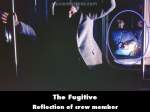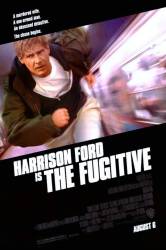
Visible crew/equipment: After Sykes shoots the Transit Cop on the "L" Richard pulls the emergency brake, and in the following shot facing Richard as the train screeches in flashes of darkness, the reflection of a crew member quickly becomes visible on the glass window beside Richard. (01:47:45)
Other mistake: After the train crash the news crews and sheriff are interviewing the surviving corrections officer. He boasts how heroic he was to rescue his partner from the wreckage, claiming that he was his partner and he would do the same for him. The only problem is that they are surprised when they find that same surviving corrections officer several scenes later and rush him to the hospital. Why would they be surprised to find an officer they already knew about?
Suggested correction: The first corrections officer had been exposed as a liar and made up the story that Kimble and Copeland were dead. Nobody believed he heroically saved his partner. Everyone assumed since the partner hadn't been found right away that he died in the wreck. It never occurred to anyone that Kimble would put his own life on the line to save a guard, so actually finding the guard alive was a surprise.
There is nothing formally wrong with the order of events here. The assumption is that the second officer's whereabouts are known at the time of the senior officer's story - but that is actually only an assumption. Finding the second officer would of course not be important to the main story in any way, and thus this sub-story was not explained in the movie. To word it an alternative better way, why would the senior officer make up this story of saving the second officer, if the officer had not been located yet?
The second officer's whereabouts are most certainly not known when the first officer is interviewed. The first officer is interviewed the night of the crash and the second officer is found the next morning.
Continuity mistake: When Kimble goes to the hospital to see Dr. Kathy Wahlund (looking into a microscope), she hugs him around his neck - in the next shot her arms are in a different spot.
Continuity mistake: Kimble puts the worker's uniform on over his prison uniform, but when he takes it off to tend to his wounds, we only see him remove the worker's uniform, with no sign of the prison uniform.
Continuity mistake: When the Marshals go to arrest Copeland, they are in Whiting, IN. When the Sheriff's car comes through, it is an Illinois State Police car.
Visible crew/equipment: The camera filming the wide shot of the press conference with the US Marshals and Chicago PD blends in with the rest of the camera crews there doing the conference. It is blatantly visible behind everyone asking questions. The angle from this camera is used at least twice. You can identify it by its film magazine. Almost all news organizations in the 1990s used video tape as opposed to film, so a film camera used during a press conference would and does stick out like a sore thumb.
Revealing mistake: Just after the opening murder scene, there's a shot of a Chicago Police van responding with blue lights flashing. If you look closely at the roof lights between the beacon on the right side of the roof you can see a sign "FILM2" stuck to the bar. (00:01:55)
Other mistake: After we see a shot of the prison bus driving along a road, the white, balding jail guard says, "20 miles to Benard. We should be there in 40 minutes." Not long after, one of the inmates begins to foam at the mouth. The black prisoner cries, "Hey, somebody, get in here quick!" The black jail guard stands up to unlock the cage, and the white, balding guy says to him, "We're almost to the prison." This is impossible considering he just mentioned the prison was 20 miles away. (00:14:52)
Suggested correction: Almost is a relative word and compared to Chicago/Cook County, they could almost be at the prison (when flying from NYC to LAX, when you are over Utah, you are almost there even though you still have like an hour to go). But more likely (and how I have always taken it to mean), the guard didn't give two cents if these prisoners died in transport and the other guard should just sit tight because they are almost where they have to go and the prison doctors can look at him then.
Continuity mistake: The prisoner starts foaming at the mouth and pulls the sharp implement from his sock, but when he is shot, he collapses back in his seat with no sign of the foam around his mouth.
Other mistake: During the St. Patrick's Day parade, the camera shows a clock that displays the temperature, which is supposedly 23°. None of the spectators or performers we see is dressed for that temperature. They would be way more bundled up than they are. Everybody is dressed for weather in the 40s or so.
Suggested correction: 20s is nice and toasty.
Character mistake: The investigators say that the prints found in Sykes' apartment belong to Kimble after dusting for them, making it clear they didn't use any equipment for fingerprint analysis or testing. No forensic investigator would confirm who the prints belong to until they run a thorough analysis. It seems as if they were basing the fact that they belonged to Kimble because they traced the call to the apartment, rather than acknowledge that the prints could belong to someone else.
Continuity mistake: When Kimble leaves the hospital and the detectives arrive, it's dark outside. However, when they're interviewing the nurse, you can see it's daylight outside.
Factual error: In the train crash scene there are many mistakes. 2 locos are pulling a hand full of cars, a small switcher loco would actually have been used. Oil journal bearings that haven't been used for decades. A flat car carrying logs, but there is no logging in the Chicagoland area. The second loco for some reason derails. In reality the train would have just pushed the bus a few hundred feet with no derailment. The shed explodes. The 200 ton loco just slides along the soft ground.
Continuity mistake: When Kimble is on the moving train, Sykes mysteriously appears from a door when he wasn't there before. (02:00:00)





